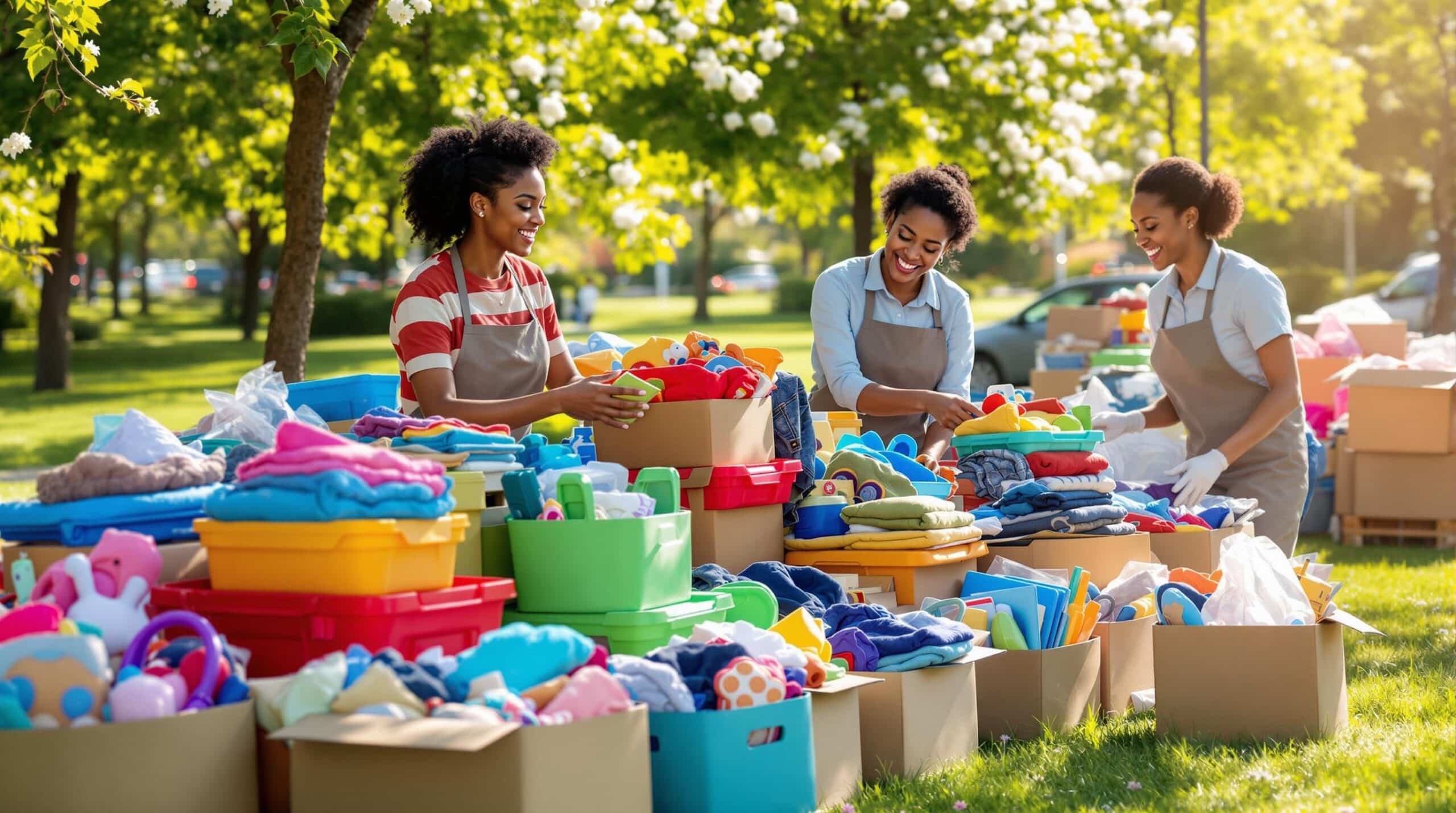Organizing your spring donations can make a big difference for your community. Here’s how to do it effectively:
- Sort Donations by Category: Group items like clothing, shoes, books, electronics, toys, and household items for easier processing.
- Check Quality: Only donate clean, functional items without damage or stains.
- Pack and Label: Use appropriate boxes, label contents clearly, and keep sets together.
- Follow Donation Rules: Check what your local center accepts and avoid prohibited items like mattresses or broken electronics.
- Choose the Right Time: Drop off donations during weekday mornings to avoid crowds.
- Prepare for Tax Deductions: Keep a detailed list of items and get a receipt for tax purposes.
- Match Seasonal Needs: Focus on high-demand items like spring clothing or household essentials.
Why Organized Donations Matter
Organized donations help City Thrift work more efficiently, ensuring that more contributions directly support community programs at City Union Mission. When items are sorted, cleaned, and categorized beforehand, processing becomes much smoother.
Statistics reveal that only 60%–70% of clothing donations make it to the sales floor. Unsorted items can lead to missed opportunities to aid the community. Streamlining this process means turning donations into meaningful support.
The Benefits of Organized Donations
- Increases Efficiency
Clean and categorized items allow staff to process donations faster, ensuring more resources go toward community programs. - Protects Other Donations
Contaminated or damaged items can ruin entire batches of donations.“The challenges for us are probably things that are, for lack of a better term, gross. So, things that have been sitting out in your yard for too long or are moldy, (mildewed), damp … if we get one of those, even in a batch of clothes, it can easily ruin other things. It means we can lose out on donations.”
- Lowers Operational Costs
Donations that arrive clean and functional reduce disposal expenses. This allows City Thrift to allocate more funds to programs run by City Union Mission.
Proper organization also minimizes risks during processing. For instance, misplaced sharp objects can create safety hazards for staff. Thoughtful sorting helps avoid these issues.
“People that actually wash their clothing before they donate and kind of fold them nicely, we always love that. If donors can do that ahead of time, that would be amazing. I understand, though, that’s not always possible, but even if people have some sort of questionable things they weren’t sure about, putting those in a bag and just writing like damaged clothing on it probably would be helpful for our staff, too.”
1. Group Items Into Categories
Start by organizing your items into clear categories. This makes the sorting process easier and more efficient.
Some useful categories to consider are:
- Clothing and accessories
- Shoes
- Books and media
- Electronics
- Small household items
- Large household items
- Toys and games
When sorting clothing, group seasonal items together – like pairing winter coats with sweaters or summer dresses with shorts – for better organization.
Practical Sorting Tips
Once everything is categorized, refine your process with a few helpful steps:
- Keep complete sets together. For example, donate all pieces of a toy set in one bag.
- Focus on one category or area at a time (like your closet) to avoid feeling overwhelmed.
Tips for Specific Categories
For electronics, gather all components and accessories. For instance, pair a DVD player with its remote and cables to ensure everything is functional.
When dealing with household items, sort them by size and purpose. Keep kitchen tools together, separate bathroom accessories, and organize decorative items on their own.
Organizing this way not only minimizes waste but also ensures that donated goods are in good condition for others to use.
2. Check Item Quality and Cleanliness
Before packing donations, take a moment to evaluate the quality of each item. Only donate things you’d feel comfortable giving to a close friend or family member. This ensures your contributions are both useful and appreciated.
Assessing Clothing Quality
Go through each piece of clothing and check for the following:
- Damage: Look for holes, tears, or frayed seams.
- Stains: Make sure there are no marks or spots that didn’t come out after washing.
- Wear and Tear: Pay attention to worn areas, especially on knees, elbows, and cuffs.
- Functionality: Confirm that zippers work and buttons are intact.
All clothing should be clean – either freshly laundered or dry-cleaned – so it’s ready for its next owner.
Electronics and Household Items
For electronics, test each item to make sure it works properly. Include any necessary components like chargers or remotes. Wipe down surfaces to sanitize them, and don’t forget to remove personal data from devices before donating.
Items to Avoid Donating
Some items aren’t suitable for donation. Avoid giving:
- Open or use personal care products
- Expired medications or vitamins
- Items with signs of pests
- Broken or non-working electronics
- Food that’s past its expiration date
“If you would not give it to your best friend, then don’t give it to us.” – Carol, Center that helps those in need
When in Doubt
Not sure about an item? Ask yourself:
- Would you buy this in its current condition?
- Is it clean and in working order?
- Does it meet basic quality expectations?
If you’re still uncertain, reach out to your local donation center for advice.
Professional attire like suits and dresses can make a big difference for someone preparing for a job interview or entering the workforce. Consider donating these items to organizations that specialize in career support programs. They can help your contributions go even further.
3. Pack and Mark Boxes Clearly
Packing and labeling boxes properly can make the donation process much smoother. Choose the right containers for your items and focus on clear organization to assist the donation center staff.
Choosing the Right Boxes
Pick box sizes based on what you’re packing:
- Small boxes (12″ x 12″ x 12″): Great for books and heavier items.
- Medium boxes (18″ x 18″ x 16″): Perfect for small appliances and kitchenware.
- Large boxes (24″ x 18″ x 18″): Best for lightweight clothing and linens.
- Extra-large boxes (24″ x 20″ x 20″): Use these for bulky items like comforters.
Packing Supplies You’ll Need
Protect your donations with these materials:
- Durable packing tape: Shipping-grade tape works best.
- Permanent markers: Broad-tip markers ensure labels are easy to read.
- Tape dispenser: Speeds up the sealing process.
Labeling for Easy Sorting
Help donation center staff by labeling boxes clearly:
- Write the contents on multiple sides of each box.
- Be specific, like “Men’s Winter Clothing Size L.”
- Indicate sets, such as “Complete Dish Set – 8 pieces.”
Packing Tips for Better Organization
Keep your packing process simple and efficient with these tips:
- Group similar items: Pack items of the same type together, like kitchen tools in one box and children’s clothes in another.
- Keep sets together: Bag or box items that belong together, such as matching sheets or dish sets, to prevent them from getting separated during sorting.
4. Check Current Donation Rules
Before dropping off your donations, make sure to confirm which items are currently accepted. Donation centers, like City Thrift, often update their guidelines based on seasonal demands, safety standards, and available space. Taking this step ensures your contributions meet their current needs.
City Thrift has specific requirements to maintain quality and safety. Their donation hours are:
- Monday through Saturday: 9 AM to 9 PM
- Sunday: 10 AM to 8 PM
Here’s what they typically accept:
- Clean, gently used clothing
- Household items in working condition
- Functional electronics
- Furniture is in good condition
- Books and media
On the other hand, these items are not accepted:
- Items with mold or mildew
- Damaged furniture
- Mattresses
- Baby cribs
- Certain appliances
Safety Regulations
Donation centers follow safety rules set by organizations like the U.S. Consumer Product Safety Commission (CPSC). To ensure your items are safe and haven’t been recalled, visit cpsc.gov before donating. These checks help make sure your donations are safe for resale.
Bulk Donations and Pickups
If you’re donating large quantities or oversized items, City Thrift offers a pickup service. Call 816-641-5656 to schedule a collection. This is a great option for:
- Multiple boxes of items
- Large furniture
- Full room cleanouts
- Heavy appliances
Double-Check Before Donating
To avoid wasted trips, review City Thrift’s website for updated guidelines, call your local center, or ask about any seasonal needs. This ensures your donations are suitable and appreciated.
5. Pick a Drop-off Time
Planning your donation drop-off at the right time can save you hassle and make the process much smoother. Knowing when donation centers are busy or quiet can help you avoid unnecessary delays.
Best Times to Donate
If you want a quicker and easier experience, aim for weekday mornings or early afternoons. Tuesday and Wednesday mornings are especially good since donation centers often restock after busy weekends. These times are less crowded, making your visit more efficient.
Times to Avoid
Late afternoons, particularly on weekends, tend to be the busiest. During these peak hours, you might face:
- Longer wait times
- Fewer staff are available to assist
- Crowded parking areas
- Slower donation processing
Timing Tips to Simplify Your Visit
To make your donation process as smooth as possible, keep these tips in mind:
- Go mid-week: Dropping off donations on a Tuesday or Wednesday works well with restocking schedules.
- Arrive early: Showing up shortly after the center opens can help you avoid crowds.
- Check staffed hours: Make sure you’re visiting when staff are available to handle your items properly.
6. Get Your Tax Receipt Ready
Keep records of your donations to stay compliant with IRS rules and make tax filing easier. The IRS requires accurate documentation for all charitable contributions, so planning can save you headaches when tax season rolls around.
Understanding Fair Market Value
The fair market value is what a buyer would pay for an item in its current condition. Here’s a quick reference for common donation values:
| Item Category | Typical Value Range |
|---|---|
| Women’s Clothing | $2 – $16 |
| Men’s Suits | $15 – $40 |
| Kitchen Sets | $40 – $100 |
| Televisions | $20 – $170 |
| Bicycles | $12 – $60 |
What Documentation Do You Need?
To claim your tax deductions, make sure you have these:
- A detailed list of donated items
- A receipt for the donation
- Special IRS forms if your non-cash donations exceed $500
Key Tax Rules
“According to the Internal Revenue Service (IRS), a taxpayer can deduct the fair market value of clothing, household goods, used furniture, shoes, books and so forth. Fair market value is the price a willing buyer would pay for them.” – Goodwill Central Coast
Only items in “good” condition or better qualify for a deduction. Keep the receipt you get when dropping off donations as proof for your tax records. This will make filing your taxes smoother when the time comes.
Get Expert Help
If your donation includes high-value or complex items, talk to a tax advisor. They can help with valuations, IRS requirements, and filling out the right forms. For more details, check out IRS Publications 526 and 561. Having your tax receipt ready ensures everything is in order, from your donation to your tax return.
7. Match Donations to Current Needs
Align your donations with current priorities to ensure they make the biggest difference for those in need. Your contributions directly fund essential programs in your community.
Understanding Seasonal Needs
Each season brings specific donation priorities. For spring, focus on items that help families adjust to changing weather. Here’s what City Thrift is currently prioritizing:
| Season | High-Priority Items |
|---|---|
| Spring | Light jackets, rain gear, and children’s clothing |
| Summer Prep | Short-sleeve shirts, shorts, sandals |
| Year-Round | Household essentials, kitchenware, furniture |
Keep these seasonal needs in mind when sorting through your donations.
Double-Check Before Donating
Before dropping off items, make sure they match current requirements:
- Visit www.citythrift.org to view the latest list of accepted items.
- Confirm donation guidelines online or by calling ahead.
- Check store hours to ensure staff will be available to accept your donations.
“Everything we do in the stores, we raise money for programs that we operate, so we take it very personal. We are taking the merchandise and creating funds to help people in the community.”
– Amy Stacey, Vice President of Retail Operations, Volunteers of America of Ohio & Indiana
Focus on Quality
City Union Mission relies on your donations to support its programs. Thrift stores often process massive amounts of items – some handle as much as 300,000 pounds of donations weekly. To make the most impact, donate items in good condition:
- Clothing should be clean, with no rips, stains, or missing buttons.
- Household items must be complete and functional.
- Electronics should be in working order.
- Furniture must be sturdy and clean.
“Giving away belongings can be an emotional experience, but you can feel good letting go when you know you’re supporting a cause that you believe in.”
– Community Thrift Store
What to Donate: Quick Guide
Before donating, it’s important to match your items with current needs and prepare them properly. Here’s a quick guide from City Thrift to help you decide what to donate and how to get everything ready.
Accepted Items
| Category | What to Donate | Preparation Tips |
|---|---|---|
| Clothing & Accessories | Seasonal clothing, shoes, and accessories | Wash and clean thoroughly |
| Home Goods | Small appliances, decor, and kitchenware | Ensure items are functional |
| Furniture | Chairs, tables, dressers | Must be clean and sturdy |
| Electronics | Flatscreen TVs (2 years or newer) | Verify they work properly |
| Exercise Equipment | Treadmills, ellipticals | Must be functional and under 10 years old |
| Special Items | Musical instruments, sports gear | Ensure all parts are included |
While these items are accepted, certain things cannot be processed.
Items We Cannot Accept
- Mattresses, box springs, and bed pillows
- Baby items like cribs and car seats
- Items with mold, mildew, or strong odors
- Tube TVs
- Building materials
- Medical supplies (except mobility aids)
- Food products
- Encyclopedias and magazines
Preparation Checklist
To make sure your donation is ready for drop-off, follow these steps:
- Clean everything thoroughly.
- Check that all parts are included.
- Group similar items together for easier sorting.
- Protect items during transport to avoid damage.
Next Steps
Your donations are ready to make a difference! City Thrift‘s donation centers are here to help you tackle your spring cleaning while supporting important community programs.
Before heading out, take these final steps for a hassle-free drop-off:
- Check donation hours: Visit www.citythrift.org or call ahead to confirm the latest operating hours.
- Organize your vehicle: Keep donations separate and easy to unload.
- Prepare tax documents: If you plan to claim a deduction, have any necessary paperwork ready.
Once you’re set, your drop-off will help support programs that matter.
“Let your old stuff…do good stuff!”
Want to do even more?
- Subscribe to City Thrift’s newsletter for updates on seasonal needs.
- Follow them on social media for news and program highlights.
- Make donation drop-offs part of your routine.
When donations are organized, City Thrift can process them more efficiently, creating a bigger impact in the community. Stick to these tips and stay connected to turn your decluttering into meaningful change.




